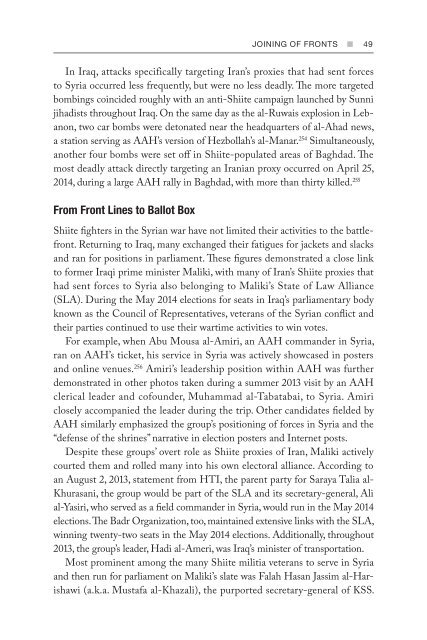You also want an ePaper? Increase the reach of your titles
YUMPU automatically turns print PDFs into web optimized ePapers that Google loves.
JO<strong>IN</strong><strong>IN</strong>G OF FRONTS n 49<br />
In Iraq, attacks specifically targeting Iran’s proxies that had sent forces<br />
to Syria occurred less frequently, but were no less deadly. The more targeted<br />
bombings coincided roughly with an anti-Shiite campaign launched by Sunni<br />
jihadists throughout Iraq. On the same day as the al-Ruwais explosion in Lebanon,<br />
two car bombs were detonated near the headquarters of al-Ahad news,<br />
a station serving as AAH’s version of Hezbollah’s al-Manar. 254 Simultaneously,<br />
another four bombs were set off in Shiite-populated areas of Baghdad. The<br />
most deadly attack directly targeting an Iranian proxy occurred on April 25,<br />
2014, during a large AAH rally in Baghdad, with more than thirty killed. 255<br />
From Front Lines to Ballot Box<br />
Shiite fighters in the Syrian war have not limited their activities to the battlefront.<br />
Returning to Iraq, many exchanged their fatigues for jackets and slacks<br />
and ran for positions in parliament. These figures demonstrated a close link<br />
to former Iraqi prime minister Maliki, with many of Iran’s Shiite proxies that<br />
had sent forces to Syria also belonging to Maliki’s State of Law Alliance<br />
(SLA). During the May 2014 elections for seats in Iraq’s parliamentary body<br />
known as the Council of Representatives, veterans of the Syrian conflict and<br />
their parties continued to use their wartime activities to win votes.<br />
For example, when Abu Mousa al-Amiri, an AAH commander in Syria,<br />
ran on AAH’s ticket, his service in Syria was actively showcased in posters<br />
and online venues. 256 Amiri’s leadership position within AAH was further<br />
demonstrated in other photos taken during a summer 2013 visit by an AAH<br />
clerical leader and cofounder, Muhammad al-Tabatabai, to Syria. Amiri<br />
closely accompanied the leader during the trip. Other candidates fielded by<br />
AAH similarly emphasized the group’s positioning of forces in Syria and the<br />
“defense of the shrines” narrative in election posters and Internet posts.<br />
Despite these groups’ overt role as Shiite proxies of Iran, Maliki actively<br />
courted them and rolled many into his own electoral alliance. According to<br />
an August 2, 2013, statement from HTI, the parent party for Saraya Talia al-<br />
Khurasani, the group would be part of the SLA and its secretary-general, Ali<br />
al-Yasiri, who served as a field commander in Syria, would run in the May 2014<br />
elections. The Badr Organization, too, maintained extensive links with the SLA,<br />
winning twenty-two seats in the May 2014 elections. Additionally, throughout<br />
2013, the group’s leader, Hadi al-Ameri, was Iraq’s minister of transportation.<br />
Most prominent among the many Shiite militia veterans to serve in Syria<br />
and then run for parliament on Maliki’s slate was Falah Hasan Jassim al-Harishawi<br />
(a.k.a. Mustafa al-Khazali), the purported secretary-general of KSS.


